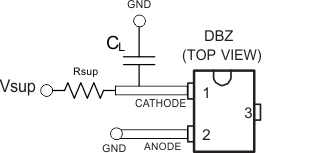SLOS456N January 2005 – October 2017
PRODUCTION DATA.
- 1 Features
- 2 Applications
- 3 Description
- 4 Revision History
- 5 Pin Configuration and Functions
-
6 Specifications
- 6.1 Absolute Maximum Ratings
- 6.2 ESD Ratings
- 6.3 Recommended Operating Conditions
- 6.4 Thermal Information
- 6.5 LM4040A20I, LM4040B20I Electrical Characteristics
- 6.6 LM4040C20I, LM4040D20I Electrical Characteristics
- 6.7 LM4040C20Q, LM4040D20Q Electrical Characteristics
- 6.8 LM4040A25I, LM4040B25I Electrical Characteristics
- 6.9 LM4040C25I, LM4040D25I Electrical Characteristics
- 6.10 LM4040C25Q, LM4040D25Q Electrical Characteristics
- 6.11 LM4040A30I, LM4040B30I Electrical Characteristics
- 6.12 LM4040C30I, LM4040D30I Electrical Characteristics
- 6.13 LM4040C30Q, LM4040D30Q Electrical Characteristics
- 6.14 LM4040A41I, LM4040B41I Electrical Characteristics
- 6.15 LM4040C41I, LM4040D41I Electrical Characteristics
- 6.16 LM4040A50I, LM4040B50I Electrical Characteristics
- 6.17 LM4040C50I, LM4040D50I Electrical Characteristics
- 6.18 LM4040C50Q, LM4040D50Q Electrical Characteristics
- 6.19 LM4040A82I, LM4040B82I Electrical Characteristics
- 6.20 LM4040C82I, LM4040D82I Electrical Characteristics
- 6.21 LM4040A10I, LM4040B10I Electrical Characteristics
- 6.22 LM4040C10I, LM4040D10I Electrical Characteristics
- 6.23 Typical Characteristics
- 7 Detailed Description
- 8 Applications and Implementation
- 9 Power Supply Recommendations
- 10Layout
- 11Device and Documentation Support
- 12Mechanical, Packaging, and Orderable Information
封装选项
机械数据 (封装 | 引脚)
散热焊盘机械数据 (封装 | 引脚)
订购信息
10 Layout
10.1 Layout Guidelines
Figure 10 shows an example of a PCB layout of LM4040XXXDBZ. Some key Vref noise considerations are:
- Connect a low-ESR, 0.1-μF (CL) ceramic bypass capacitor on the cathode pin node.
- Decouple other active devices in the system per the device specifications.
- Using a solid ground plane helps distribute heat and reduces electromagnetic interference (EMI) noise pickup.
- Place the external components as close to the device as possible. This configuration prevents parasitic errors (such as the Seebeck effect) from occurring.
- Do not run sensitive analog traces in parallel with digital traces. Avoid crossing digital and analog traces if possible and only make perpendicular crossings when absolutely necessary.
10.2 Layout Example
 Figure 10. DBZ Layout example
Figure 10. DBZ Layout example